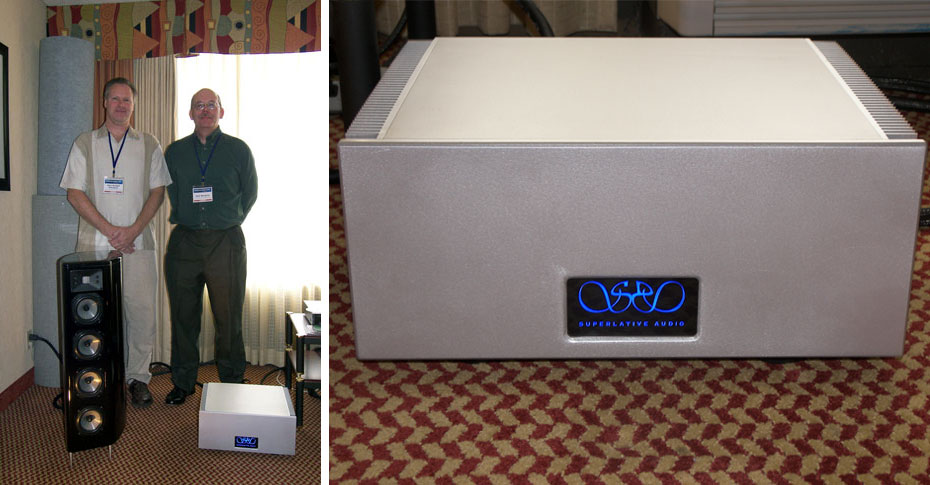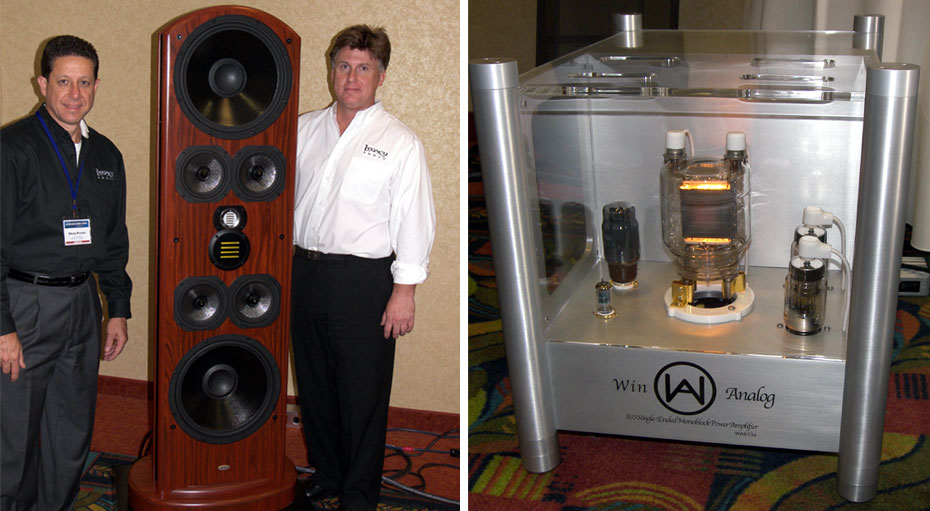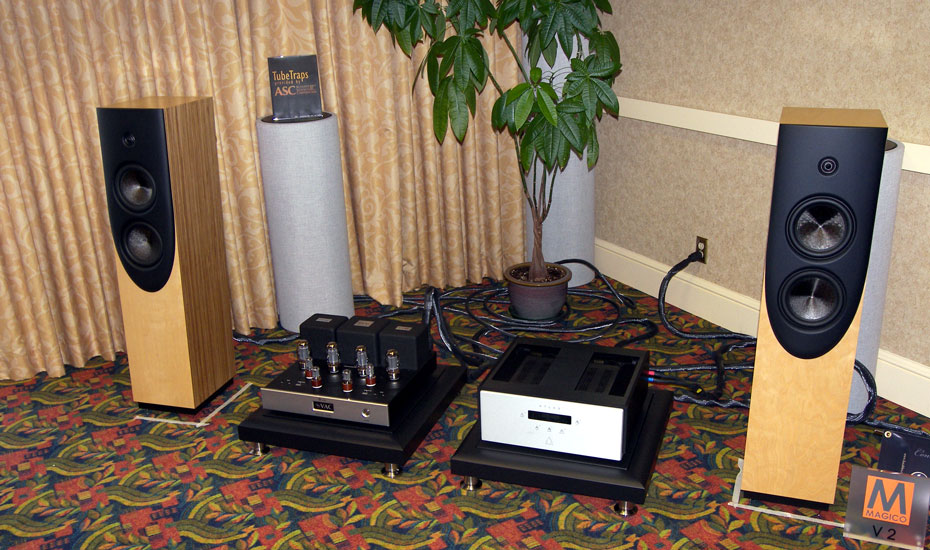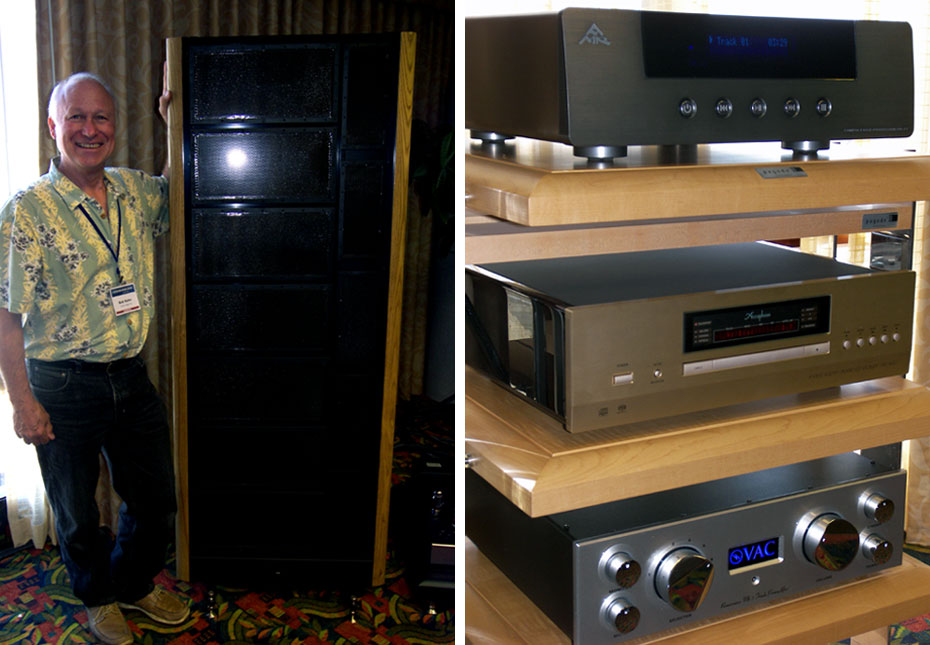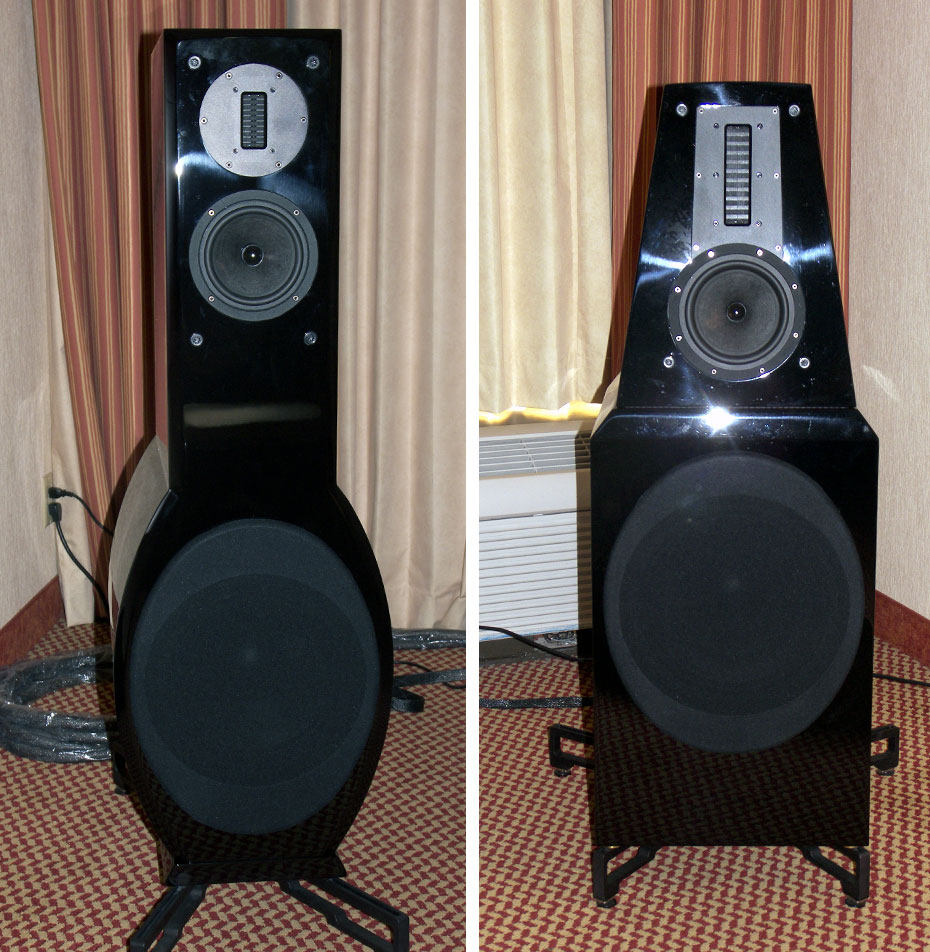The first time show attendee may not realize it, but the system in any given room which is heard on the first day is not necessarily the same system heard on the last day. Components are frequently swapped, cables alternated, room treatments added, and speaker systems exchanged. It is a good policy, if possible, to visit one’s potential favorites later in the show, as this is the time when it is most assured that any issues with performance may have been worked out. I offer here four instances of systems in flux over the course of the show, all of which had admirable sound when they finally settled.
Setup is a very important thing for audio shows in two particular aspects. One is the equipment chosen to accompany a product. Nick Wingate and Alan Hulaebus of Raven Design presented the Ebb speakers ($12,000) with a combination of costly and economical gear. I spied what appeared to be an Oppo BDP-83 SE ($899), Benchmark Media DAC1HDR ($1,895), and Superlative Audio SSA-200 amplifiers ($30,000/pair). Cabling was supplied by Clarity Cables; Vortex Power Cord (2M/$750), Organic XLR Interconnects (2M/$2,400/pair), and Organic Speaker Cables (2M/$2,500/pair). The Ebb uses a 1” Raven tweeter, four forward firing Focal 4” mid/bass drivers and two similar defeatable rear-firing drivers.
Early on in the show, this rig did not sound as though it was dialed in properly. Its imaging was off and the bass was bloated. To be fair, many systems were struggling with bass issues. Later in the show, Nick wanted me to return to the room as they had discovered something important – the speakers were not symmetrically placed; one was 4” closer to the head wall. Though they had painstakingly followed the carpet pattern to get perfect positioning, they later realized the carpet was not perfectly laid! Consequently their positioning was off. I wonder how many other exhibitors did this and suffered, but did not discover it. Indeed, that one fix rendered the system a much improved sound as the focus was heightened and bass cleaner. Had much higher-end electronics and perfect positioning greeted show goers their impression may have been vastly different. When a system doesn’t sound perfect to the ear there are usually very good reasons; the audiophile needs to consider system and room variables in discerning what’s happening with the sound.
Statement speakers are meant to be shown with statement amplification. Such was the goal of Legacy Audio, which offers the Whisper XD ($20,000 standard finish). The speaker is a hybrid active/passive design; it features internal IcePower™ amplification for the bass and external amplification for the midrange and treble, as well as outboard crossover. However, an exhibit can be plagued by a significant problem, as it was for Win Analog, co-exhibitor and maker of the fabulously beautiful appearing and sounding Z845 vacuum tube preamplifier ($45,000) and S Series monoblock amplifier ($75,000/pair). I have heard the Win Analog components at previous shows and they have been stunning. The preamp arrived at the show with a horrible hum in the right channel and little could be done to rectify it; the unit sat idle most of the show. It was replaced by an INEX Innovation Photon Preamp ($12,500). Also employed was the next-generation Lindeman 825 player with outboard power supply and 384 kHz upsampling ($12,500), and MIT’s selectable impedance cabling, the Oracle MA-X Interconnects ($7,995/1 M) and Magnum MA Speaker Cables ($7,995/8ft pair). Watch for my review of the Oracle and Magnum products upcoming.
Those who heard the system early on Friday were possibly disappointed; the rig was suffering the effects of the Win Analog problems. After it was switched out and the rig recalibrated, a different tune was being sung by Friday late afternoon. I didn’t hear it early, but I did hear it at length on Sunday and found it to be quite satisfactory. I walked in as some high-power organ music was cranked up and noted how the Whisper filled the large exhibit room effortlessly. I’ll be reserved in my comments here as I am currently working on a review of a unique version of the Whisper.
Occupying the only other show room on the top floor of the Emeryville Hilton was another speaker which I am using as my reference panel, the Kingsound “The King” full-range ESL ($8,500). I would also enjoy saying I am using the Magico V-3 ($27,000) also on display by Oakland dealer Audio Image Ltd.; perhaps sometime soon. Among supporting components were the Accuphase DP-600 SACD player ($20,000), the VAC Renaissance MkIII Preamp with optional phono stage ($9,900), and alternating between the VAC Phi 200 tube amplifier ($9,900) and the Aesthetix Atlas Hybrid Amplifier ($8,000). Cabling was the Kubala-Sosna Elation line (Speaker $6,000+; Interconnects $6,000+; Power Cords $1,800+) and Audience Adept Response aR6 ($3,100). The Pagode Master Reference HD03 Rack ($7,200) and Master Reference Amp Stands ($1,600) were used. Room treatment was by Acoustic Sciences Corporation (or A.S.C.; prices vary by length and diameter).
Initially, the Phi 200 at 100wpc into 2,4, and 8 Ohms (200wpc in mono) was set up with the King but it was deemed underpowered for extremely dynamic music, i.e. organ at higher listening levels. I am currently reviewing the Phi 200 and have not encountered that problem. Possibly a significant factor was that in the show system the 4-8 Ohm speaker posts were being used; I normally use the 1-2 Ohm binding posts as the King is difficult to drive. The Aesthetix Atlas was summoned (200wpc into 8 Ohms; 400wpc into 4 Ohms) and the King sprang to his feet.
I had suggested a specialty power cable be employed on the VAC Royal Power Supplies used on the King. However, when placed into the rig the speaker exhibited an intermittent static/noise sound playing at a higher level. Bob and crew were perplexed, however I had encountered this very issue in my own system. In my experience, over months of using it the King needs more than a few moments to recharge fully when it has been disconnected. If driven too hard when first hooked up, the speaker will clip, yielding the soft static sound. However no damage to the speaker would occur. After several hours of operation the speaker would be at full charge and the anomaly should disappear.
It can be unnerving to a person at an audition if they hear something amiss with a rig. Had I not been aware of the nature of the King and its need to be fully charged, I might have been alarmed by this anomaly. There are usually quite good explanations as to why a system might exhibit a quirk. It is premature to simply write off components, as is illustrated in the example below.
Sometimes the speaker chosen for display is not set up optimally for the exhibit room and it appears the manufacturer cannot address it immediately. This seemed to be the case in the room with the following system: Exemplar Expo Universal Player, a highly modded Oppo 83 ($2,500 player cost incl.); Exemplar XP-2 Preamplifier ($12,999); David Berning Quadrature Z with Stillpoints ($33,000/pair); Prototype “Stillwire” cables by Stillpoints, and the Efici’on F250 ($9,000/pair) and F300 speakers ($16,999; $20,000 with Stillpoints upgrade).
On day one, I heard the F250 and was unimpressed. It was flabby and indistinct and the drivers were not as coherent as I would have liked given the design. Passing by the room on day three I noticed that the F300, its larger sibling, was sitting in its place. Had I written off the company from the initial experience I would have missed the second, competent exhibit. I opted for giving Efici’on a second chance.
It seemed the first demo had been a case of speaker and room not integrating well. I much preferred the F300, which was surprising given that it is larger than the F250! Now the system had ease, no bass bloat, and strong coherency between drivers. As it is now, I’m intrigued by them, and the second audition of the F300 suggests that the F250 could be a capable speaker which was heard in a hostile room. That the larger model in the same small room sounded better by a long shot shoots down, in at least this instance, the rule that smaller speakers sound better in small rooms.
The above are examples of real world conditions and situations which audiophiles may face, even exhibitors at shows. Very few systems and components are truly fool-proof; most rigs have potential pitfalls, including the infamous mistake of speakers being cross-wired or wired out of phase. At every show I have attended I have encountered it! Audiophiles are not the only ones with good gear engaged in hunting down sound issues. When addressed properly, as in these cases, the result is superb sound. If you hear a rig at a show that doesn’t sound quite right, it’s possible that in a day or two it will, because the limiting factor has been discovered!
- (Page 1 of 1)

